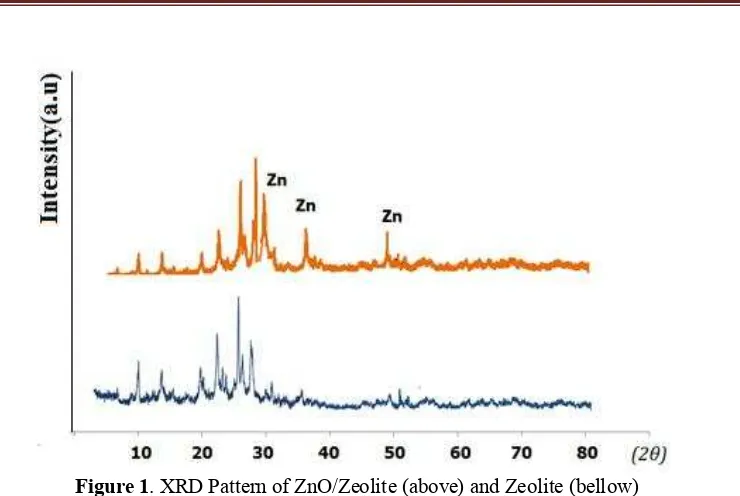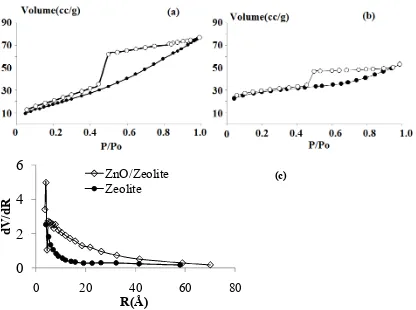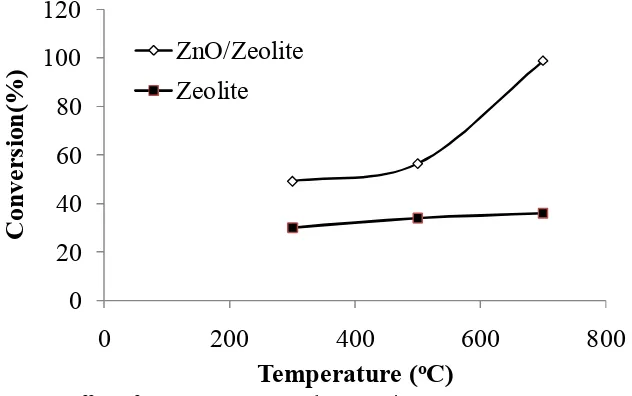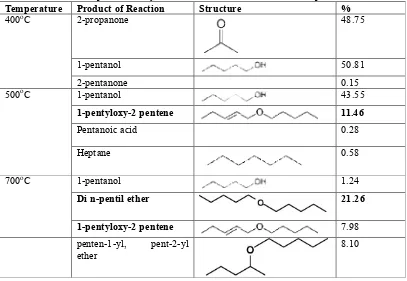C-10
PREPARATION AND MECHANISTIC STUDY OF ZnO/ZEOLITE AS CATALYST IN 1-PENTANOL DEHYDRATION
Is Fatimah
Chemistry Department, Islamic Univesityof Indonesia
Jl. Kaliurang Km 14, Sleman, Yogyakarta 55581, email: [email protected]
ABSTRACT
Preparation of zinc oxide impregnated zeolite from natural zeolite and its catalytic activity in pentanol dehydration was investigated. The impregnation process was conducted by two main steps; chemical activation followed by wet impregnation using ZnSO4.7H2O as precursor and the characterization of prepared material was conducted by
X-ray diffraction, scanning electron microscope (SEM-EDX) and surface acidity measured by pyridine adsorption-FTIR spectrophotometric method. As catalytic activity evaluation, pentanol dehydration over prepared material under vapor phase reaction mechanism was conducted by varied temperature of 300,400, 500 and 700oC. For mechanistic study, the product of reactions was analyzed by using gas chromatography-mass spectrometry(GC-MS) . It is found that temperature affect strongly to the reaction mechanism in that at the temperature of above 500oC the etherification was occured. From the comparation with zeolite, it can be noticed that the role of solid acidity also influences the reaction mechanism.
Keywords: Alcohol Dehydration, Natural Zeolite, Impregnatio, Heterogeneous Catalysis.
Introduction
The zeolite used as raw materialin this research was natural zeolite obtained from Klaten, Jawa Tengah Indonesia.The powder of zeolite was chemically activated by refluxing in hydrochloric acid 0.1M for 6h followed by neutralization before using. Zinc acetate dyhydrate (ZnO.2H2O), ethanol, 1-pentanol were purchasedfrom Merck-Millipore.
ZnO/zeolite catalyst was prepared by impregnation method. Precursor solution prepared from zinc acetate dilluted in ethanol:water solvent was dispersed into zeolite powder slurry followed by stirring for a night. Solvent was then evaporated slowly before drying and calcined at 700oC for 5h. Powder of ZnO/Zeolite was characterized by x-ray diffraction(XRD) analysis
collected using Shimadzu X6000 instrument, gas sorption analysis by NOVA1200e and surface acidity determination by pyridine adsorption-FTIR analysis. Sampel in a dessicator was evacuated for 4h before expossed with pyridine vapor for a night and measured by using FTIR spectrophotometer after reevacuation for 1h. An AVATAR FTIR spectrophotometer instrument was utilized for this purpose. Pentanol as feed was vaporized befor was purged into catalyst coloumn at varied temperature. The temperature inside the reactor wascontrolled with a CAL 9500P controller (CAL Controls Ltd.). Product of reaction was condensed and the liquid was then analyzed using a GCMS instrument. Reaction parameters of catalyst activity, total conversion and product selectivity were calculated based on GCMS analysis by using following equation[4]:
(%) = [1 − [ ] − [1 −] ] 100%
(%) = 1 − 1 − 100%
(%) = 1 − [ − ] 100%
[1-pentanol]o, [1-pentanol]p are peak area of 1-pentanol in feed and product respectively
Result and Discussion
Physicochemical character of catalyst plays role in the catalysis mechanism. As catalyst in alcohol dehydration, the presence of surface acidity and surface active sites will directly drives the interaction amongs reactants. Confirmation on the formation of chrystalline and porous structure from the dispersion of ZnO on zeolite surface was observed by x-ray diffraction and Brunair-Emmet-Teller(BET) isotherm adsorption-desorption profile from gas sorption analysis. XRD pattern of both ZnO/zeolite and activated natural zeolite is depicted in Figure 1.
Figure 1. XRD Pattern of ZnO/Zeolite (above) and Zeolite (bellow)
ZnO impregnation also affects to the N2 adsorption-desorption profile as presented in
Figure 2 contribute to the specific surface area, pore volume and pore radius data listed in Table 1. Although was not significantly different, the adsorption capability of ZnO/zeolite is higher compared to zeolite as shown by the higher volume adsorbed at all P/Po condition. Pore
distribution appeared in Figure 2(c) showed that ZnO/Zeolite has higher volume at all pore radius. From the calculation based on the adsorption with BET isotherm data, the higher specific surface area and pore volume were recorded(Table 1) while the pore radius of ZnO/Zeolite is lower than that of Zeolite. This is the indication of the ZnO aggregates formation on surfaces which tends to create aggregate pores.
Table 1. Surface Parameter from BET Surface Area Analysis of ZnO/Zeolite and Zeolite
Catalyst Specific Surface
area(m2/g) Pore Radius(Å) Pore (cc/g) volume
ZnO/Zeolite 80.67 12.21 38.56 x10-3
Figure 2. Adsorption-Desorption Profile of ZnO/Zeolite and Zeolite
0
2
4
6
0
20
40
60
80
dV/dR
R(Å)
ZnO/Zeolite
Table 2. Total Acidity and Lewis to Broensted Acidity Ratio of ZnO/Zeolite and Zeolite
Sample Acidity pyridine/g) (mmol Total Acidity (mg butylammine/g) L/B ratio
Activated Zeolite 0.460 0.775 0.99
ZnO/Zeolite 0.760 1.110 1.09
Catalytic activity of ionized zeolite is related to the presence of acid sites from tetrahedral [AlO4]5- of zeolite frawework in that these sites have character to be both Broensted
and Lewis acid. Pyridine adsorption followed by FTIR analysis and also determination of total acidity by using n-butylammine titration were used to observed surface acidity qualitative and quantitatively. Analysis of surface acidity by using pyridine adsorption is based on the interaction between aromatic ring and nitrogen atom of pyridine. Aromatic ring of pyridine can bind to Broensted acid of H+ and other protons from zeolite structure while nitrogen atom can
coordinatively bind to Lewis acid sites i.e from Zn atom supported on surface. Spectra of FTIR is presented in Figure 3 and the data on total acidity and also Lewis to Broensted acidity ratio are compiled in Table 2.
Symmetrical bending of Al-O-Al and Si-O-Si are appeared at 650-720 cm-1 while
absorbance at the region of 950-1250 cm-1 are correspond to asymmetric strecthing. The
interaction between adsorbed pyridine are indicated from some peaks at around 1450.52 cm -1and 1546.72 cm-1 which correlated to the bonding between N of pyridine and proton (H+) of
zeolite. From the calculation based on FTIR spectra it can be noted that ZnO/Zeolite has higher total acidity and also L/B ratio. The insertion of zinc oxide particles are the main reason for the enhancement of acidity because of the contribution of d-orbitals of dispersed Zn. Lewis acid-base interaction comes from the bonding between electrone pairs of nitrogen to the formation Zn with coordination bonding.
Figure 4. Effect of Temperature on Total Conversion
Catalytic activity test of prepared material showed that the total conversion increased
zeolite. In advance analysis of converted products catalyzed by ZnO/Zeolite were determined by using GCMS analysis as listed in Table 3. It can be seen that at 400oC the product consisted
of 2-pentanone which is also produced over activated zeolite at all temperature condition. The yield was gradually changed with increasing temperature whereas at 500oC and 700oC the
product of 1-pentyloxy pentene was formed. The product was observed only over ZnO/Zeolite which indicate the role of ZnO as active sites in the catalysis mechanism.
At relative low temperature (400oC) thermal effect seems occured since the product of
2-propanone was found. The route of conversion probably consist of thermal cracking to produce ethylene gas and followed by oxidation to produce 2-propanone. The domination of thermal effect compared to catalytic effect may related to that catalyst was in the inactive condition. As the temperature increased, the product of 1-pentyloxy-2-pentene, penten-1-yl, pent-2-yl ether and di-n-pentyl ether were produced and gradually enhanced by higher temperature. The mechanism of etherification whitin the dehydration was dominantly occured within both varied temperatures. The possible mechanism occurs is presented in schematic mechanism as modified from [8].
Table 3. Product of 1-pentanol dehydration over ZnO/Zeolite at varied temperature
Temperature Product of Reaction Structure %
400oC 2-propanone 48.75
1-pentanol 50.81
2-pentanone 0.15
500oC 1-pentanol 43.55
1-pentyloxy-2 pentene 11.46
Pentanoic acid 0.28
Heptane 0.58
700oC 1-pentanol 1.24
Di n-pentil ether 21.26
1-pentyloxy-2 pentene 7.98
penten-1-yl, pent-2-yl
Figure 5. Schematic Possible Mechanism of 1-pentanol Dehydration as modified from Mohammed and El-Esaimi[8]
1-pentyloxy-2-pentene(5) is probably produced from the bimolecular interaction between pent-1-ene(2) and carbocation (1). The ionic interaction has higher possibility and theoretically enhanced since the surface active of Zn on zeolite surface active[4]. The possible route for the formation of this compound attribute to the strong adsorption of intermediate product(1) and (2) by the surface leads to the structural rearangement to form the compound(4). It is also showed by the presence of heptane as a result as well as propanoic acid. At higher reaction temperature of 700oC, it can be seen that penten-1-yl, pent-2-yl ether(6) and
di-n-pentyl ether(4) were produced. The product of (4) is the main chemical targetted in this mechanism as reported by several authors [4], [8], [9] while the product (5) was similar compound that was also reported from the 1-pentanol dehydration over zeolite[8]. From elucidating the mechanism it can be concluded that ZnO impregnation onto zeolite surface contributes significantly to the surface activity and that is strongly correlated to the surface acidity improvement.
Conclusion
mechanism. An important concept presented from the varied temperature is that surface active properties of ZnO/Zeolite affects the mechanism involved via the adsorption of reactant by Zn metal dispersed on solid support. Bimolecular interaction on surface occurs at the temperature 500oC and 700oC while at 400oC thermal effect is relatively dominant.
References
[1] D. E. R. P.A. Zapata, J.Faria, M. P.Ruiz, R.E. Jentoft, “Hydrophobic Zeolites for Biofuel Upgrading Reactions at the Liquid− Liquid Interface in Water/Oil Emulsions,” J Am Chem Soc, vol. 2, no. x, 2012.
[2] P. P. A.Corma, “Catalytic Activity of Modified Silicates: Dehydration of Ethanol Catalyzed by Acidic Sepiolite,” Clay Miner, vol. 22, pp. 423–433, 1987.
[3] B. Huang, Q. Liu, J. Caro, and A. Huang, “Iso-butanol dehydration by pervaporation using zeolite LTA membranes prepared on 3-aminopropyltriethoxysilane-modified alumina tubes,” J Memb Sci, vol. 455, pp. 200–206, Apr. 2014.
[4] J. Tejero, F. Cunill, M. Iborra, J. F. Izquierdo, and C. Fité, “Dehydration of 1-pentanol to di-n-pentyl ether over ion-exchange resin catalysts,” J Mol Catal A Chem, vol. 182–183, pp. 541–554, May 2002.
[5] L. S. A. Arcoya, A. Gonzales, N. Traviesco, “Physicochemical and Catalytic Properties of a Modified Natural Clinoptilolite,” Clay Miner, vol. 28, pp. 123–131, 1994.
[6] Y. T. Prabhu, K. V. Rao, V. Sesha, S. Kumar, and B. S. Kumari, “Synthesis of ZnO Nanoparticles by a Novel Surfactant Assisted Amine Combustion Method,” vol. 2013, no. February, pp. 45–50, 2013.
[7] N. F. Hamedani and F. Farzaneh, “Synthesis of ZnO Nanocrystals with Hexagonal ( Wurtzite ) Structure in Water Using Microwave Irradiation,” vol. 17, no. 3, pp. 231–234, 2006.
[8] M. M. Mohamed and M. M. Al-Esaimi, “Synergistic catalysis effect in pentanol conversion into di-n-pentyl ether on ZSM-5 supported titania catalysts synthesized by sol–gel,” Mater Chem Phys, vol. 115, no. 1, pp. 209–216, May 2009.




![Figure 5. Schematic Possible Mechanism of 1-pentanol Dehydration as modified from Mohammed and El-Esaimi[8]](https://thumb-ap.123doks.com/thumbv2/123dok/1074958.873536/7.612.108.500.97.444/figure-schematic-possible-mechanism-pentanol-dehydration-modified-mohammed.webp)